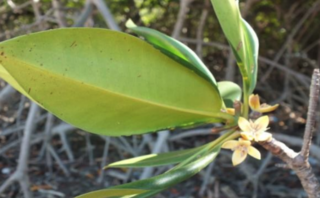
Palaquium is a genus of about 120 species of trees in the family Sapotaceae. Their range is from India across Southeast Asia, Malesia, Papuasia, and Australasia, to the western Pacific Islands.

Aquilaria is a genus of fifteen species of trees, called lign aloes or lign-aloes trees, in the family Thymelaeaceae, native to southeast Asia. They occur particularly in the rainforests of Indonesia, Thailand, Cambodia, Laos, Vietnam, Malaysia, Northeast India, Bangladesh, the Philippines, Borneo and New Guinea. The trees grow to 6–20 m tall. The leaves are alternate, 5–11 cm long and 2–4 cm broad, with a short acuminate apex and an entire margin. The flowers are yellowish-green, produced in an umbel; the fruit is a woody capsule 2.5–3 cm long.

Sterculia is a genus of flowering plants in the mallow family, Malvaceae: subfamily Sterculioideae. Members of the genus are colloquially known as tropical chestnuts. Sterculia may be monoecious or dioecious, and its flowers unisexual or bisexual.
Anisophyllea beccariana is a tree of tropical Asia in the family Anisophylleaceae. It is named for the Italian botanist Odoardo Beccari.
Anisophyllea chartacea is a tree of Borneo in the family Anisophylleaceae. The specific epithet chartacea is from the Latin meaning "papery", referring to the leaves.
Anisophyllea corneri is a tree of tropical Asia in the family Anisophylleaceae. It is named for the English botanist Edred John Henry Corner.
Anisophyllea disticha is a plant of tropical Asia in the family Anisophylleaceae. The specific epithet disticha is from the Latin meaning "2-ranked", referring to the leaf arrangement.
Anisophyllea ferruginea is a tree of Borneo in the family Anisophylleaceae. The specific epithet ferruginea is from the Latin meaning "rust-coloured", referring to the leaf hairs.
Anisophyllea globosa is a tree of Borneo in the family Anisophylleaceae. The specific epithet globosa is from the Latin meaning "round", referring to the fruits.
Anisophyllea impressinervia is a tree of Borneo in the family Anisophylleaceae. The specific epithet impressinervia is from the Latin meaning "sunken veins", referring to the leaf veins.
Anisophyllea nitida is a tree of Borneo in the family Anisophylleaceae. The specific epithet nitida is from the Latin meaning "polished", referring to the shiny appearance of the upper leaf surface.

Gomphia is a genus of plant in the family Ochnaceae. The generic name is from the Greek meaning "thorn or spike", referring to the shape of the flower base when the fruit develops.

Olax is a plant genus in the family Olacaceae. The name derives from the Latin, olax (malodorous), and refers to the unpleasant scent of some of the Olax species. Olax is an Old World genus represented by several climbers, some species have leaves and fruits smelling of garlic such as Olax subscorpioidea and Olax gambecola, seeds of the latter are used as condiments in parts of West Africa. In India Olax nana is well known as one of the first species to emerge after forest fires, the shoots growing directly from buried roots.

Sorindeia is a genus of some three dozen plant species that are native to tropical Africa, Madagascar, the Comoro Islands and Mascarene Islands. They are distinguished by their compound leaves, large inflorescences and distinctive fruit. In the case of S. madagascariensis, as many as 200 fruit may be carried on a pendant cluster.

Salacia is a genus of plants in the family Celastraceae. They are woody climbers naturally found in tropical regions.

Cola is a genus of trees native to the tropical forests of Africa, classified in the family Malvaceae, subfamily Sterculioideae. Species in this genus are sometimes referred to as kola tree or kola nut for the caffeine-containing fruit produced by the trees that is often used as a flavoring ingredient in beverages. The genus was thought to be closely related to the South American genus Theobroma, or cocoa, but the latter is now placed in a different subfamily. They are evergreen trees, growing up to 20 m tall, with glossy ovoid leaves up to 30 cm long and star-shaped fruit.

Ceriops decandra is a mangrove plant of tropical Asia in the family Rhizophoraceae. The specific epithet decandra is from the Greek meaning "ten male", referring to the flower having ten stamens.









